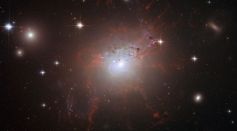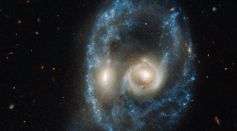Tags: Galaxies

Star Fuel Reservoirs That Surround Galaxies, Enable Formation of New Planets

Most Detailed 3D Map of the Universe Showcases 7.5 Million Galaxies Surveyed Using 5,000 Telescopes

Dark Matter Secrets Revealed: Scientists Discover 12 Streams of Stars in Milky Way Galaxy

James Webb Space Telescope: NASA Observatory Will Show Us How Galaxies Are Formed

Is NASA’s Top Priority the Discovery of Other Kinds of Life and Possible Habitat Apart from Earth?
How Black Holes Form: New Simulation Video Shows How Galaxies Feed Supermassive Mouths
Star Factories Are Major Polluters of the Universe, Study Showed
Is the Milky Way Sending Earth A Message? Scientists Now Close to Uncovering This Strange Signal
It's Cosmic Dawn! When Stars Were Formed 250 Million to 350 Million Years After Beginning of Universe
Gigantic Galactic Wind Discovered: Researchers Say It is from 13.1 Billion Years Ago
Life on Venus: Will NASA Make This Possible on Earth's Twin Planet?
Largest, Most Accurate Image to Date of the Universe Mapped by Dark Energy Survey
Hubble Image Exhibits Dazzling Galaxies of All Shapes and Sizes

Milky Way’s Outermost Regions Unveiled by New All-Sky Map

Previously Unidentified Galaxy Clusters Discovered Passing Thru Sea of Hot Gas
South Africa's MeerKAT Telescope Discovered Two Giant Radio Galaxies

Hubble Captures a Ghoulish Image Produced by Twin Galaxies Colliding
Dark Matter: Mysterious Energy Of Elusive Force That Connects The Universe
Galaxies Study Report: Polar Structure Has Been Formed After The Milky Way
Hubble Space Telescope Image: Spotted Two Interacting NGC3447 Galaxies
Most Popular

How Electric Vehicles vs Gasoline Cars Compare on Carbon Emissions and Green Transportation

Why Solar Maximum Drives More CMEs: Sunspot Activity and the Solar Cycle 25 Breakdown

How Solar Flares and CMEs Affect Life on Earth: 10 Space Weather Impacts Explained

Are Nanoparticles Really Safe? A Deep Dive into Nanotoxicology and its Environmental Impact





